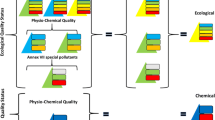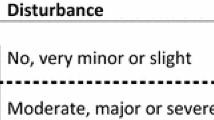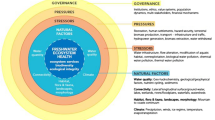Abstract
The ‘normative definitions’ of ecological water quality classes given by the Water Framework Directive (WFD) are narrative descriptions of the conditions present in water bodies of different qualities relative to reference conditions found in unimpacted sites. In order to fill these descriptions with a more solid content, the definitions have been a subject of intensive development of quantitative methodologies for ecological status assessment as well as for rules and criteria for setting of reference conditions and ecological status boundaries for classification of water bodies. In this article, we recall the basic principles of the WFD that sometimes have been overlooked and point out some gaps remained and problems arisen during the ongoing implementation of the directive. Defining type-specific reference conditions for water bodies and finding biological metrics that sensitively reflect only the anthropogenic deviations from those conditions are the biggest challenges that the ecological status assessment faces. So far, there is no guarantee that reference conditions are comparable across EU Member States due to a lack of common criteria, which need still to be elaborated. Defining site-specific reference conditions instead of type specific is a novel approach that allows for minimizing uncertainties introduced by applying broad types. Search for new metrics has led to a real boom of multimetric indices which ought to be the adequate tool to measure the multiple human impairments but which should pass a thorough check before being included in monitoring programs. Curiously, some biological indices constructed as surrogates for chemistry (especially nutrients) start ‘living their own life’ and continue indicating the disturbance when the controlling factors change. This shows the obvious advantage of biological indicators against chemical ones. New challenges to WFD implementation are brought about by the need to consider the effects of alien species and climate change in the assessment framework, and by the nonlinear dose—response relationships dominating in biological systems. Attempts to diminish uncertainties in quality assessment have become a new labour-intensive field for researchers.

Similar content being viewed by others
References
Blukacz, E. A., W. G. Sprules & J. Brunner, 2005. Use of bootstrap for error propagation in estimating zooplankton production. Ecology 86: 2223–2231.
Borics, G., I. Grigorszky, S. Szabó & J. Padisák, 2000. Phytoplankton associations under changing pattern of bottom-up vs. top-down control in a small hypertrophic fishpond in East Hungary. Hydrobiologia 424: 79–90.
Borja, A., A. Miles, A. Occhipinti-Ambrogi & T. Berg, 2009. Current status of macroinvertebrate methods used for assessing the quality of European marine waters: implementing the Water Framework Directive. Hydrobiologia. doi:10.1007/s10750-009-9881-y.
Braun-Blanquet, J., 1925. Zur Wertung der Gesellschaftstreue in der Pflanzensoziologie. Vierteljahrsschrift der Naturforschenden Gesellschaft in Zürich 70: 122–149.
Burgman, M. A., D. B. Lindenmeyer & J. Elith, 2005. Managing landscapes for conservation under uncertainty. Ecology 86: 2007–2017.
Calbet, A. & M. R. Landry, 2004. Phytoplankton growth, microzooplankton grazing, and carbon cycling in marine systems. Limnology and Oceanography 49: 51–57.
Cardoso, A. C. & G. Free, 2008. Incorporating invasive alien species into ecological assessment in the context of the Water Framework Directive. Aquatic Invasions 3: 361–366.
Cardoso, A. C., A. Solimini, G. Premazzi, L. Carvalho, A. Lyche & S. Relolainen, 2007. Phosphorus reference concentrations in European lakes. Hydrobiologia 584: 3–12.
Carletti, A., Jowett, D. & A.-S. Heiskanen (eds), 2009. Water Framework Directive Intercalibration Technical Report. Part 3: Coastal and Transitional Waters. JRC Scientific and Technical Reports, EUR 23838 EN/3: 240 pp.
Carlson, R. E., 1977. A trophic state index for lakes. Limnology & Oceanography 22: 361–369.
Carstensen, J., 2007. Statistical principles for ecological status classification of Water Framework Directive monitoring data. Marine Pollution Bulletin 55: 3–15.
Carstensen, L. & P. Henriksen, 2009. Phytoplankton biomass response to nitrogen inputs: a method for WFD boundary setting applied to Danish coastal waters. Hydrobiologia. doi:10.1007/s10750-009-9867-9.
Carvalho, L., A. Solimini, G. Phillips, O-P. Pietiläinen, J. Moe, A. C. Cardoso, A. L. Solheim, I. Ott, M. Søndergaard, G. Tartari & S. Rekolainen, 2009. Site-specific chlorophyll reference conditions for lakes in Northern and Western Europe. Hydrobiologia. doi:10.1007/s10750-009-9876-8.
CIS, 2003a. River and lakes – typology, reference conditions and classification systems. Common Implementation Strategy for the Water Framework Directive (2000/60/EC), Guidance document 10, European Commission: 86 pp.
CIS, 2003b. Transitional and Coastal Waters – Typology, Reference Conditions and Classification Systems. Common Implementation Strategy for the Water Framework Directive (2000/60/EC), Guidance document 5, Working Group 2.4 – COAST, European Commission: 119 pp.
CIS, 2005. Towards a guidance document on eutrophication assessment in the context of European water policies. Common Implementation Strategy for the Water Framework Directive (2000/60/EC). Interim document. European Commission: 133 pp.
CIS, 2009. Guidance document on exemptions to the environmental objectives. Common Implementation Strategy for the Water Framework Directive (2000/60/EC), Guidance document 20. European Commission: 46 pp.
Daskalov, G. M., 2002. Overfishing drives a trophic cascade in the Black Sea. Marine Ecology Progress Series 225: 53–63.
Devlin, M., J. Barry, S. Painting & M. Best, 2009. Extending the phytoplankton tool kit for the UK Water Framework Directive: indicators of phytoplankton community structure. Hydrobiologia. doi:10.1007/s10750-009-9879-5.
Directive, 2000. Directive 2000/60/EC of the European Parliament and of the council of 23 October 2000 establishing a framework for community action in the field of water policy. Official Journal of the European Communities L 327: 1–72.
Directive, 2008. Directive 2008/56/EC of the European Parliament and of the council of 17 June 2008 establishing a framework for community action in the field of marine environmental policy (Marine Strategy Framework Directive). Official Journal of the European Communities L 164: 19–40.
Dokulil, M. T. & K. Teubner, 2005. Do phytoplankton communities correctly track trophic changes? An assessment using directly measured and palaeolimnological data. Freshwater Biology 50: 1589–1593.
Dokulil, M. T., K. Teubner & J. Greisberger, 2005. Typenspezifische Referenzbedingungen für die integrierende Bewertung des ökologischen Zustandes stehender Gewässer Österreichs Gemäß der EU-Wasserrahmenrichtlinie. Modul 1: Die Bewertung der Phytoplankton Struktur nach dem Brettum-Index. Projektstudie Phase 3, Abschlussbericht. Im Auftrag des Bundesministeriums für Land- und Forstwirtschaft, Umwelt und Wasserwirtschaft, Wien.
Donohue, I., L. A. Donohue, B. Ní Ainín & K. Irvine, 2009. Assessment of eutrophication pressure on lakes using littoral invertebrates. Hydrobiologia. doi:10.1007/s10750-009-9868-8
Duarte, C. M., D. J. Conley, J. Carstensen & M. Sánchez-Camacho, 2009. Return to Neverland: shifting baselines affect eutrophication restoration targets. Estuaries and Coasts 32: 29–36.
Dufour, S. & S. Piégay, 2009. From the myth of a lost paradise to targeted river restoration: forget natural references and focus on human benefits. River Research and Applications 25: 568–581.
Erba, S., M. T. Furse, R. Balestrini, A. Christodoulides, T. Ofenböck, W. van de Bund, J.-G. Wasson & A. Buffagni, 2009. The validation of common European class boundaries for river benthic macroinvertebrates to facilitate the intercalibration process of the Water Framework Directive. Hydrobiologia. doi:10.1007/s10750-009-9873-y
European Commission, 2008. Commission decision of 30 October 2008 establishing, pursuant to Directive 2000/60/EC of the European Parliament and of the Council, the values of the Member State monitoring system classifications as a result of the intercalibration exercise Official Journal of the European Union L 332: 20–44.
Hajnal, É. & J. Padisák, 2008. Analysis of long-term ecological status of Lake Balaton based on the ALMOBAL phytoplankton database. Hydrobiologia 599: 227–237.
Hering, D., C. K. Feld, O. Moog & T. Ofenböck, 2006. Cook book for the development of a multimetric index for biological condition of aquatic ecosystems: experiences from the European AQEM and STAR projects and related initiatives. Hydrobiologia 566: 311–324.
Irvine, K., 2004. Classifying ecological status under the European Water Framework Directive: the need for monitoring to account for natural variability. Aquatic Conservation: Marine and Freshwater Ecosystems 14: 107–112.
Jeppesen, E., J. P. Jensen, M. Søndergaard, M. Fenger-Grøn, S. Sandby, P. Hald Møller & H. U. Rasmussen, 2004. Does fish predation influence zooplankton community structure and grazing during winter in north-temperate lakes? Freshwater Biology 49: 432–447.
Johnson, R. K., D. Hering, M. T. Furse & R. T. Clarke, 2006. Detection of ecological change using multiple organism groups: metrics and uncertainty. Hydrobiologia 566: 115–137.
Kaiblinger, C., O. Anneville, R. Tadonleke, F. Rimet, J. C. Druart, J. Guillard & M. T. Dokulil, 2009. Central European water quality indices applied to long-term data from peri-alpine lakes: test and possible improvements. Hydrobiologia. doi:10.1007/s10750-009-9877-7.
Karr, J. R., 1981. Assessment of biotic integrity using fish communities. Fisheries 6: 21–27.
Karr, J. R. & E. W. Chu, 1997. Biological monitoring and assessment: using multimetric indexes effectively. EPA 235–R07-001. University of Washington, Seattle, WA: 149 pp.
Kelly, M., H. Bennion, A. Burgess, J. Ellis, S. Juggins, R. Guthrie, J. Jamieson, V. Adriaenssens & M. Yallop, 2009. Uncertainty in ecological status assessments of lakes and rivers using diatoms. Hydrobiologia. doi:10.1007/s10750-009-9872-z
Kolkwitz, R. & M. Marsson, 1908. Ökologie der pflanzlichen Saprobien. Berichte der Deutschen Botanischen Gesellschaft 26a: 505–519.
Kolkwitz, R. & M. Marsson, 1909. Ökologie der tierischen Saprobien. Beiträge zur Lehre von der biologischen Gewässerbeurteilung. Internationale Revue der gesamten Hydrobiologie und Hydrographie 2: 126–152.
LAWA, 1999. Gewässerbewertung – Stehende Gewässer. Vorläufige Richtlinie für eine Erstbewertung von natürlich entstandenen Seen nach trophischen Kriterien. Kulturbuch Verlag, Berlin: 1–74.
Lo, E., 2005. Gaussian error propagation applied to ecological data: post-ice-storm-downed woody biomass. Ecological Monographs 75: 451–466.
Lopez y Royo, C., C. Silvestri, M. Salivas-Decaux, G. Pergent & G. Casazza, 2009. Application of an angiosperm based classification system (BiPo) to Mediterranean coastal waters: using spatial analysis and data on metal contamination of plants in identifying sources of pressure. Hydrobiologia. doi:10.1007/s10750-009-9880-z
Lyche Solcheim, A. (ed.), 2005. Reference conditions of European lakes. Indicators and methods for the Water Framework Directive assessment of reference conditions, REBECCA Project, deliverable 7: 105 pp.
Mischke, U., U. Riedmüller, E. Hoehn, I. Schönfelder & B. Nixdorf, 2008. Description of the German system for phytoplankton-based assessment of lakes for implementation of the EU Water Framework Directive (WFD). In Mischke, U. & B. Nixdorf (eds), Brandenburg Technical University of Cottbus, ISBN 978-3-940471-06-2, BTUC-AR 2/2008: 117–146.
Moss, B., 2007. Shallow lakes, the water framework directive and life. What should it all be about? Hydrobiologia 584: 381–394.
Moss, B., 2008. The Water Framework Directive: total environment or political compromise? Science of the Total Environment 400: 32–41.
Moss, B., D. Stephen, C. Alvarez, E. Becares, W. Van de Bund, S. E. Collings, E. Van Donk, E. De Eyto, T. Feldmann, C. Fernandez-Alaez, M. Fernandez Alaez, R. J. M. Franken, F. Garcia-Criado, E. Gross, M. Gyllstrom, L.-A. Hansson, K. Irvine, A. Järvalt, J. P. Jensen, E. Jeppesen, T. Kairesalo, R. Kornijow, T. Krause, H. Künnap, A. Laas, E. Lill, B. Lorens, H. Luup, M. R. Miracle, P. Nõges, T. Nõges, M. Nykanen, I. Ott, W. Peczula, E. T. H. M. Peeters, G. Phillips, S. Romo, V. Russell, J. Salujõe, M. Scheffer, K. Siewertsen, H. Smal, T. Virro, E. Vicente & D. Wilson, 2003. The determination of ecological status in shallow lakes – a tested system (ECOFRAME) for implementation of the European Water Framework Directive. Aquatic Conservation: Marine & Freshwater Ecosystems 13: 507–549.
Nõges, P., W. van de Bund, A. C. Cardoso & A. S. Heiskanen, 2007. Impact of climatic variability on parameters used in typology and ecological quality assessment of surface waters – implications on the Water Framework Directive. Hydrobiologia 584: 373–379.
Nõges, P., U. Mischke, R. Laugaste & A. G. Solimini, submitted. Analysis of 44-year changes in phytoplankton of Lake Võrtsjärv (Estonia): the effect of nutrients, climate, and the investigator on phytoplankton based water quality indices. Hydrobiologia.
Ocampo-Duque, W., N. Ferré-Huguet, J. L. Domingo & M. Schuhmacher, 2006. Assessing water quality in rivers with fuzzy inference systems: a case study. Environment International 32: 733–742.
Ocampo-Duque, W., M. Schuhmacher & J. L. Domingo, 2007. A neural-fuzzy approach to classify the ecological status in surface waters. Environmental Pollution 148: 634–641.
Olenin, S., D. Minchin & D. Daunys, 2007. Assessment of biopollution in aquatic ecosystems. Marine Pollution Bulletin 55: 379–394.
Padisák, J. & C. S. Reynolds, 1998. Selection of phytoplankton associations in Lake Balaton, Hungary, in response to eutrophication and restoration measures, with special reference to the cyanoprokaryotes. Hydrobiologia 384: 41–53.
Padisák, J., I. Grigorszky, G. Borics & É. Soróczki-Pintér, 2006. Use of phytoplankton assemblages for monitoring ecological status of lakes within the Water Framework Directive: the assemblage index. Hydrobiologia 553: 1–14.
Pall, K. & V. Moser, 2009. Austrian Index Macrophytes (AIM-Module 1) for lakes: a Water Framework Directive (WFD) compliant assessment system for lakes using aquatic macrophytes. Hydrobiologia. doi:10.1007/s10750-009-9871-0
Poikane, S. (ed.), 2009. Water Framework Directive intercalibration technical report. Part 2: Lakes. JRC Scientific and Technical Reports, EUR 23838 EN/2: 176 pp.
Ptacnik, R., A. G. Solimini & P. Brettum, 2009. Performance of a new phytoplankton composition metric along a eutrophication gradient in Nordic lakes. Hydrobiologia. doi:10.1007/s10750-009-9870-1
Rawson, D. S., 1956. Algal indicators of trophic lakes types. Limnology & Oceanography 1: 18–25.
Reynolds, C. S., 1998. What factors influence the species composition of phytoplankton in lakes of different trophic status? Hydrobiologia 369(370): 11–26.
Schneider, S. & A. Melzer, 2003. The Trophic Index of Macrophytes (TIM) – a new tool for indicating the trophic state of running waters. International Review of Hydrobiology 88: 49–67.
Schriver, P., J. Bøgestrand, E. Jeppesen & M. Søndergaard, 1995. Impact of submerged macrophytes on the interactions between fish, zooplankton and phytoplankton: large-scale enclosure experiments in a shallow lake. Freshwater Biology 33: 255–270.
Solimini, A. G., P. Gulia, M. Monfrinotti & G. Carchini, 2000. Performance of different biotic indices and sampling methods in assessing water quality in the lowland stretch of the Tiber River. Hydrobiologia 422(423): 197–208.
Solimini, A., A. C. Cardoso, A.-S. Heiskanen (eds), 2006. Indicators and methods for the Ecological Status Assessment under the Water Framework Directive. Linkages between chemical and biological quality of surface waters. EUR 22314 EN. European Commission: 248 pp.
Solimini, A. G., M. Bazzanti, A. Ruggiero & G. Carchini, 2008. Developing a multimetric index of ecological integrity based on macroinvertebrates of mountain ponds in central Italy. Hydrobiologia 597: 109–123.
Solimini, A. G., R. Ptacnik & A. C. Cardoso, 2009. Toward a holistic assessment of ecosystem functioning: the relationships between anthropogenic pressures, chemical and ecological status under the Water Framework Directive. Trends in Analytical Chemistry 28: 143–147.
Søndergaard, M. & B. Moss, 1998. Impact of submerged macrophytes on phytoplankton in shallow freshwater lakes. In Jeppesen, E., Ma. Søndergaard, Mo. Søndergaard & K. Christoffersen (eds), The Structuring Role of Submerged Macrophytes in Lakes. Ecological Studies Series 131. Springer, New York: 115–132.
Stansfield, J. H., M. R. Perrow, L. D. Tench, A. J. D. Jowitt & A. A. L. Taylor, 1997. Submerged macrophytes as refuges for grazing Cladocera against fish predation: observations on seasonal changes in relation to macrophyte cover and predation pressure. Hydrobiologia 342(343): 229–240.
UNESCO, 2000. Solving the Puzzle: The Ecosystem Approach and Biosphere Reserves. UNESCO, Paris.
van de Bund, W. (ed.), 2009. Water Framework Directive intercalibration tecnical report. Part 1: Rivers. JRC Scientific and Technical Reports, EUR 23838 EN/1: 136 pp.
Vighi, M., A. Finizio & S. Villa, 2006. The evolution of the environmental quality concept: from the US EPA Red Book to the European Water Framework Directive. Environmental Science and Pollution Research 13: 9–14.
Watt, A. D., R. H. W. Bradshaw, J. Young, D. Alard, T. Bolger, D. Chamberlain, F. Fernández-González, R. Fuller, P. Gurrea, K. Henle, R. Johnson, Z. Korsós, P. Lavelle, J. Niemelä, P. Nowicki, M. Rebane, C. Scheidegger, J. P. Sousa, C. van Swaay & A. Vanbergen, 2007. Trends in biodiversity in Europe and the impact of land-use change. In Harrison, R. M. & R. E. Hester (eds), Biodiversity under Threat. Issues in Environmental Science and Technology 25. Royal Society of Chemistry, Cambridge: 135–160.
Willén, E., 2007. Växtplankton i sjöar. Bedömningsgrunder. SLU, Institutionen för Miljöanalys, Rapport 2007: 5, 33 pp.
Wolfram, G., C. Argillier, J. de Bortoli, F. Buzzi, A. Dalmiglio, M. T. Dokulil, E. Hoehn, A. Marchetto, P.-J. Martinez, G. Morabito, M. Reichmann, Š. Remec-Rekar, U. Riedmüller, C. Rioury, J. Schaumburg, L. Schulz & G. Urbanič, 2009. Reference conditions and WFD compliant class boundaries for phytoplankton biomass and chlorophyll-a in Alpine lakes. Hydrobiologia. doi:10.1007/s10750-009-9875-9
Acknowledgements
The study was supported by EU FP7 grant 226273 (WISER). Special thanks go to Dr. Judit Padisák for her valuable comments and suggestions.
Author information
Authors and Affiliations
Corresponding author
Additional information
Guest editors: P. Nõges, W. van de Bund, A. C. Cardoso, A. G. Solimini & A.-S. Heiskanen
Assessment of the Ecological Status of European Surface Waters.
Rights and permissions
About this article
Cite this article
Nõges, P., van de Bund, W., Cardoso, A.C. et al. Assessment of the ecological status of European surface waters: a work in progress. Hydrobiologia 633, 197–211 (2009). https://doi.org/10.1007/s10750-009-9883-9
Published:
Issue Date:
DOI: https://doi.org/10.1007/s10750-009-9883-9




